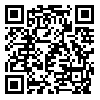BibTeX | RIS | EndNote | Medlars | ProCite | Reference Manager | RefWorks
Send citation to:
URL: http://cjns.gums.ac.ir/article-1-91-fa.html
Background: Carpal tunnel syndrome is the most common neuropathy in the general population. Nerve conduction studies are among the standard methods for diagnosing carpal tunnel syndrome. Electromyography is painful and unpleasant, and if nerve conduction studies can be used to diagnose axonal injury in carpal tunnel syndrome, electromyography might be replaced.
Objectives: This study aimed to evaluate the predictability of electromyography findings by nerve conduction studies.
Materials and Methods: This cross-sectional study recruited 47 patients with carpal tunnel syndrome who attended electrodiagnostic unit in teaching hospitals in Isfahan in the spring and summer of 2015, among who both hands of 46 patients and only the left hand of one person were evaluated. Patients were selected by non-probability sampling and the relationship between parameters of nerve conduction studies and electromyography findings were determined based on the information obtained. The data were analyzed by Spearman’s test and Mann-Whitney test in SPSS-22.
Results: The mean and standard deviation of participants’ age was 47.5±9.1 (range: 62-34 years old). According to data analysis, 37.6% of patients were diagnosed with neurogenic MUAP and 32.2% with neurogenic spontaneous activity. Based on the results, among 47 patients with carpal tunnel syndrome, CMAP amplitudes were most relevant to the findings of neurogenic electromyography among parameters of nerve conduction studies (31.2%) (p-value=0.002).
Conclusion: According to the results, axonal damage in carpal tunnel syndrome can be diagnosed by nerve conduction studies, especially in cases where electromyography is not possible (such as coagulation disorders, patient’s dissatisfaction, etc.).
| بازنشر اطلاعات | |
 | این مقاله تحت شرایط Creative Commons Attribution-NonCommercial 4.0 International License قابل بازنشر است. |


